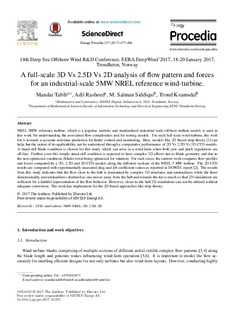| dc.contributor.author | Tabib, Mandar | |
| dc.contributor.author | Rasheed, Adil | |
| dc.contributor.author | Siddiqui, Muhammad Salman | |
| dc.contributor.author | Kvamsdal, Trond | |
| dc.date.accessioned | 2017-12-19T09:02:50Z | |
| dc.date.available | 2017-12-19T09:02:50Z | |
| dc.date.created | 2017-12-17T16:42:30Z | |
| dc.date.issued | 2017 | |
| dc.identifier.citation | Energy Procedia. 2017, 137 477-486. | nb_NO |
| dc.identifier.issn | 1876-6102 | |
| dc.identifier.uri | http://hdl.handle.net/11250/2472719 | |
| dc.description.abstract | NREL 5MW reference turbine, which is a popular, realistic and standardized industrial scale offshore turbine model, is used in this work for understanding the associated flow-complexities and for testing models. For such full-scale wind-turbine, the wish list is towards a accurate real-time prediction for better control and monitoring. Here, models like 2D based strip-theory [1] can help, but the extent of its applicability can be understood through a comparative performance of 2D Vs 2.5D Vs 3D CFD models. A stand-still blade condition is chosen for this study which can arise in a wind-farm when both yaw and pitch regulations are off-line. Further, even this simple stand-still condition is expected to have complex 3D effects due to blade geometry and due to the non-optimized conditions (blades twist being optimized for rotation). For such cases, the current work compares flow-profiles and forces computed by a 3D, 2.5D and 2D CFD models along the different sections of the NREL 5 MW turbine. The 2D CFD results are compared with experimentally measured drag and lift coefficient values as reported in DOWEC report [2]. The results from this study indicates that the flow close to the hub is dominated by complex 3D structures and unsteadiness while the three dimensionality and unsteadiness diminish as one moves away from the hub and towards the tip so much so that 2D simulations are sufficient for a faithful representation of the flow behavior. However, closer to the hub 2D simulations can not be utilized without adequate corrections. The work has implications for the 2D based approaches like strip-theory. | nb_NO |
| dc.language.iso | eng | nb_NO |
| dc.rights | Attribution-NonCommercial-NoDerivatives 4.0 Internasjonal | * |
| dc.rights.uri | http://creativecommons.org/licenses/by-nc-nd/4.0/deed.no | * |
| dc.title | A full-scale 3D Vs 2.5D Vs 2D analysis of flow pattern and forces for an industrial-scale 5MW NREL reference wind-turbine | nb_NO |
| dc.type | Journal article | nb_NO |
| dc.type | Peer reviewed | nb_NO |
| dc.description.version | publishedVersion | nb_NO |
| dc.source.pagenumber | 477-486 | nb_NO |
| dc.source.volume | 137 | nb_NO |
| dc.source.journal | Energy Procedia | nb_NO |
| dc.identifier.doi | https://doi.org/10.1016/j.egypro.2017.10.372 | |
| dc.identifier.cristin | 1528532 | |
| dc.relation.project | Norges forskningsråd: 216465 | nb_NO |
| cristin.unitcode | 7401,90,11,0 | |
| cristin.unitname | Anvendt matematikk | |
| cristin.ispublished | true | |
| cristin.fulltext | original | |
| cristin.qualitycode | 1 | |

